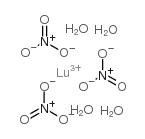10099-67-9
| Name | lutetium nitrate hexahydrate |
|---|---|
| Synonyms |
Lutecium nitrate
Trinitric acid lutetium salt LUTETIUM NITRATE TETRAHYDRATE Nitric acid lutetium lutetium trinitrate EINECS 233-241-7 Lutetium nitrate hydrate/ |
| Boiling Point | 83ºC at 760 mmHg |
|---|---|
| Molecular Formula | H8LuN3O13 |
| Molecular Weight | 433.04300 |
| Exact Mass | 432.94600 |
| PSA | 243.56000 |
| LogP | 0.59510 |
| Appearance | crystal | white |
| Vapour Pressure | 49.8mmHg at 25°C |
| Water Solubility | soluble H2O, EtOH [CRC10] |
|
Section 1: Product Identification Chemical Name:Lutetium (III) nitrate hydrate(99.9%-Lu) (REO) CAS Registry Number:10099-67-9 Formula:Lu(NO3)3.XH2O EINECS Number:none Chemical Family:metal nitrate salts Synonym:Nitric acid, lutetium(3+) salt
Section 2: Composition and Information on Ingredients IngredientCAS NumberPercentACGIH (TWA)OSHA (PEL) Title Compound10099-67-9100%no datano data Section 3: Hazards Identification Emergency Overview:Irritating to eyes, skin and respiratory tract. May be harmful if swallowed. Primary Routes of Exposure:Ingestion Eye Contact:Causes slight to mild irritation of the eyes Skin Contact:Causes slight to mild irritation of the skin. Inhalation:Irritating to the nose, mucous membranes and respiratory tract. Ingestion:Ingestion may lead to dizziness, abdominal cramps, vomiting, bloody diarrhea, weakness, and convulsions. Acute Health Affects:Irritating to skin, eyes and respiratory tract. Chronic Health Affects:No information available on long-term chronic effects. NTP:No IARC:No OSHA:No SECTION 4: First Aid Measures Immediately flush the eyes with copious amounts of water for at least 10-15 minutes. A victim may need Eye Exposure: assistance in keeping their eye lids open. Get immediate medical attention. Wash the affected area with water. Remove contaminated clothes if necessary. Seek medical assistance if Skin Exposure: irritation persists. Remove the victim to fresh air. Closely monitor the victim for signs of respiratory problems, such as difficulty Inhalation: in breathing, coughing, wheezing, or pain. In such cases seek immediate medical assistance. Seek medical attention immediately. Keep the victim calm. Give the victim water (only if conscious). Induce Ingestion: vomiting only if directed by medical personnel. SECTION 5: Fire Fighting Measures Flash Point:not applicable Autoignition Temperature:none Explosion Limits:none Extinguishing Medium:carbon dioxide, foam or dry powder If this product is involved in a fire, fire fighters should be equipped with a NIOSH approved positive pressure Special Fire Fighting Procedures: self-contained breathing apparatus and full protective clothing. Hazardous Combustion andIf involved in a fire this material may emit irritating fumes. Decomposion Products: Unusual Fire or Explosion Hazards: Metal nitrates can be oxidizers. Contact with strong reducing agents could lead to fires and/or explosions. SECTION 6: Accidental Release Measures Spill and Leak Procedures:Small spills can be mixed with vermiculite or sodium carbonate and swept up. SECTION 7: Handling and Storage Handling and Storage:Store in a tightly sealed container. Keep away from heat and direct sunlight. SECTION 8: Exposure Controls and Personal Protection Eye Protection:Always wear approved safety glasses when handling a chemical substance in the laboratory. Skin Protection:Wear protective clothing and gloves. Ventilation:If possible, handle the material in an efficient fume hood. If ventilation is not available a respirator should be worn. The use of respirators requires a Respiratory Respirator: Protection Program to be in compliance with 29 CFR 1910.134. Ventilation:If possible, handle the material in an efficient fume hood. Additional Protection:No additional protection required. SECTION 9: Physical and Chemical Properties Color and Form:white xtl. Molecular Weight:360.98 Melting Point:no data Boiling Point:no data Vapor Pressure:not applicable Specific Gravity:no data Odor:none Solubility in Water:very soluble SECTION 10: Stability and Reactivity Stability:air and moisture stable Hazardous Polymerization:no hazardous polymerization Contact with strong reducing agents or organic matter. Some nitrates can explode if heated to high Conditions to Avoid: temperatures. Incompatibility:reducing agents, organic matter, phosphorus and sulfur Decomposition Products:nitrogen oxides and lutetium salts SECTION 11: Toxicological Information RTECS Data:Intraperitoneal (rat); LD50: 258 mg/kg. Intraperitoneal (mouse); LD50: 223 mg/kg. Carcinogenic Effects:No data available Mutagenic Effects:No data available Tetratogenic Effects:No data available SECTION 12: Ecological Information Ecological Information:No data available SECTION 13: Disposal Considerations Disposal:Dispose of according to local, state and federal regulations. SECTION 14: Transportation Shipping Name (CFR):Nitrates, Inorganic, N.O.S. Hazard Class (CFR):5.1 Additional Hazard Class (CFR):NA Packaging Group (CFR):II UN ID Number (CFR):UN# 1477 Shipping Name (IATA):Nitrates, Inorganic, N.O.S. Hazard Class (IATA):5.1 Additional Hazard Class (IATA):NA Packaging Group (IATA):II UN ID Number (IATA):UN# 1477 SECTION 15: Regulatory Information TSCA:Listed in the TSCA inventory. SARA (Title 313):Title Compound: See Category Code N511 for reporting. Second Ingredient:none SECTION 16 - ADDITIONAL INFORMATION N/A |
CHEMICAL IDENTIFICATION
HEALTH HAZARD DATAACUTE TOXICITY DATA
|
| Hazard Codes | O |
|---|---|
| Risk Phrases | R8 |
| Safety Phrases | 17-36/37/39 |
| RIDADR | UN 1477 |
| Packaging Group | II |
| Hazard Class | 5.1 |
